Today we’re delving into the exciting world of Toklheim card battles with Legends Reborn, created by the talented team at Clash Craft Studios. After its launch at the beginning of this week, players are looking forward to the Litepaper’s release and the game’s first reward season, where they’ll have an opportunity to receive $TOLK for the first time.
As a cutting-edge web3 trading card game, Legends Reborn merges the strategic depth of deck building and classic PvP TCG mechanics with the innovative ownership and reward possibilities offered by web3 tech. All this is made possible by GalaChain’s robust and scalable infrastructure.
Today, we’re thrilled to present a casual Q&A with Govind Nair, one of the leading minds behind this groundbreaking game. Govind shares insights into the game’s development, the inspiration behind it, and how web3 technology enhances the trading card game experience.
Now, on with some insights from Clash Craft Studios’ Director of Design and Product, Govind Nair!
Govind, can you share with us some of your personal gaming interests growing up? Were there any card games in particular that captured your imagination?
My first experience with games was Prince of Persia, the MS-DOS version. The moment I heard the clink of the swords in combat, I knew games would be a large part of my life. Over the years, my favorite game was Fallout 2, this probably pushed me into thinking about games like a designer.
Like many, my first brush with Card games has to be Pokemon. Just the collection of the cards was so evocative that I didn’t even really know how to play until a few years later after getting that first card. Hearthstone is the obvious introduction to Digital Card games which I thoroughly enjoyed. Lately though the Roguelite Deck Builders have really got me hooked – Slay the Spire, Monster Train and Luck be a Landlord (okay, it’s a stretch to call that a card game but the systems are definitely there) are some of my favorites. Hopefully, Legends Reborn becomes really successful and Gala Games wants us to make a Roguelite Deck Builder around the IP. Trust me, we already have designs around how to do it!
The Clash Craft Studios team has brought a unique vision to life with “Legends Reborn.” What are some of your team’s favorite games, and how have they influenced the game’s development?
From the beginning of this project, our approach has never been to be a Hearthstone or a Legends of Runterra with Web3. We believed that the game had to be unique and fun, so the game would incentivize card players to come into Web3 and not the other way around. So just taking an existing game was out of the question, it wasn’t a long term sustainable approach.
We established Hearthstone, LOTR and MTG players as the core audience for the game. In terms of complexity, we wanted it to feel somewhere between Hearthstone and LOTR.
Legends Reborn stands out for integrating web3 technology into the classic TCG format. Can you explain how this technology enhances the gameplay and ownership experience for players?
Broadly speaking, we looked at this technology as a way to mirror the aspects of a physical TCG into a digital TCG. The fundamentals of our feature set were meant to emulate what we expect from a physical card game.
Cards and Creatures – With the ability to trade and rent Creatures and Cards; we want to simulate the ability for players to buy and own cards that they can trade with each other. As one sees in real life, preparing for a tournament has one tailor their deck by borrowing and buying cards based on the requirements of the tournament and the current meta. We plan to facilitate the trading and reselling aspect through web3 features like NFT Minting and a rental system.
Venues – Currently this feature only supports the hosting of matches. But our long term vision with this feature is to simulate custom tournaments where Venue owners can set rules for their own tournament, create requirements on what cards/creatures can and cannot be used, set an entry cost and so on. Eventually, all we want to do is provide interesting card packs as developers and let players decide how to create modes of play and tournament rules; similar to a physical card game.
The concept of ownership and receiving rewards is a pivotal aspect of Legends Reborn. How do you see this changing the way players interact with and value their in-game assets?
Something we really must not forget is that you have to make a fun game first. That is absolutely a must, because only then will players care about the content of your game. But once you have a sizable engaged community, then you can start rewarding players for being good. For those who have been following gaming news; esports is struggling to find a sustainable business model. The reason is that a suitable economic equation hasn’t been created to reward esports players for the number of players they bring into the ecosystem by being awesome at the game. The advantage with web3 is that the reward structure is modeled in right from the beginning.
With Legends Reborn launching on Gala Games, what advantages does GalaChain provide, and how does it support the game’s vision and mechanics?
More than anything, it’s about easy access to and contact with the devs of the chain. We have some crazy ideas for the rental and Venue features– The equally crazy peeps on the GalaChain team are eager to entertain these ideas and innovate ways to make them a reality.
Finally, for aspiring game developers intrigued by web3 technology, what advice would you give them based on your experiences developing Legends Reborn?
Make a fun game first. Don’t rip off an existing game with web3 added on top. We need to get non web3 gamers into the fold. If someone enjoys Fortnite and has spent 100 hours in it; they aren’t going to leave that game behind so easily. Give them a gameplay-centric reason to come over, then they’ll see what they’ve been missing.
Govind’s passion for gaming and belief in the power of web3 to transform the digital entertainment landscape is evident throughout this exciting new game. The team at Clash Craft Studios has not only created an engaging game but also paved the way for future developers to explore the limitless possibilities of web3 gaming and player empowerment.
Stay tuned for more updates on Legends Reborn and other exciting developments within the Gala Games ecosystem. As we continue to push the boundaries of gaming, remember that the future of entertainment is here, and it’s powered by web3 and GalaChain – where ownership, innovation, and community come together to create truly empowering experiences.


